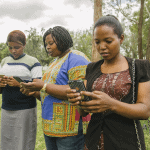Outdated but Not Obsolete: Why USSD Is Still Key to Driving Digital Inclusion in Sub-Saharan Africa
COVID-19 has accelerated the digitization of businesses, but many Africans are still not equipped to participate in the digital economy. Most of sub-Saharan Africa (SSA) remains unconnected to the internet, unable to access digital services and take part in the digital revolution sweeping the world.
Although mobile broadband is the most popular means of accessing the internet in the region, mobile internet adoption stood at just 26% at the end of 2019, according to the Global System for Mobile Communications Association. SSA accounts for almost half of the global population not covered by a mobile broadband network. Even for those who have access to the internet, it is expensive and unreliable. Therefore, as public and private efforts mount to boost internet penetration in the long term, there is a need to explore options that improve digital access in the short to medium term.
Unstructured Supplementary Service Data (USSD) is a communications protocol used by GSM cellular telephones to communicate with the network operator’s computers. It is a mobile protocol that does not require the end-user to have an internet connection, and it is being utilized across the region to connect people to basic digital services. It allows mobile phone users to dial a string of characters, usually starting with an asterisk and ending with a hash (*1234#), to access a bare-bones, text-based menu.
A SIMPLE INTERFACE FOR BROAD REACH
While many would describe it as bland and uninspiring in this age of smartphones and flashy apps, USSD has proven to be quite functional. The protocol has been put to innovative use on the continent — from Lagos to Nairobi to Johannesburg — with services ranging from mobile finance to farmer support. It has even been leveraged for pandemic support: Last year, the South African government set up a COVID-19 Connect service to help citizens locate coronavirus guidance. While WhatsApp is the preferred messaging platform in South Africa, the COVID-19 Connect service, deployed on both WhatsApp and USSD, was accessed by the majority via USSD. In Nigeria, USSD is the most-used digital channel for retail banking customers, as confirmed by some of the country’s biggest commercial banks. As Victor Asemota, a veteran technology entrepreneur on the continent puts it: “We already have a super app and it is called USSD.”
USSD has a simple user interface that most people, regardless of digital literacy level, can grasp easily. This gives digital novices an entry point before they are introduced to the more complex world of mobile and web applications. Users of feature phones who already use the USSD function to check and recharge their prepaid account balances can simply extend that know-how to operate other services. There are even many smartphone owners in Nigeria who prefer to use their dial pads to connect with their bank instead of a mobile or web application. For those who choose USSD, especially for simple functions like recharging mobile airtime, it offers the advantages of greater speed, less friction and the ability to circumvent unreliable internet services.
Feature phones are also ubiquitous in sub-Saharan Africa, since most people are unable to afford smartphones due to their income levels, making USSD the most available option for the masses. In SSA, more than 40% of the population still live below the poverty line. Many of these people do not have running water, electricity or a toilet, yet they own a feature phone. The USSD function on these inexpensive feature phones provides this population with their best chance at connectivity.
USSD’s power to reach a broader audience in SSA presents a wide range of possibilities. For instance, a farmer in a remote Togolese or Ugandan village without the internet can access banking services on a basic GSM phone and request weather forecasts or farming information. Workers in the informal economy can connect to employment opportunities, order medications or purchase essential items from online stores, even without internet access.
THE RISKS AND LIMITATIONS OF USSD
Of course, despite its advantages, USSD also has severe limitations. It was originally developed for use internally by mobile network operators, and the developers probably never envisaged that it would see such innovative use in the future. USSD’s most obvious limitation is its drab, text-only user interface, which offers no opportunity for graphics to provide users with visual cues or improve aesthetics. However, for those new to the digital space, this might be beneficial, since a simple interface may be easier to understand.
A more intractable challenge is security. As Biyi Oyelere, a senior software engineer in Lagos, Nigeria, who has spent years developing USSD applications, explained to me, “[USSD] data cannot be encrypted, and this means that they are visible on the backend. Security of such information depends on the integrity of the persons who have access to the backend.” Additionally, it is relatively difficult for businesses to set up USSD applications, because it requires complicated approvals, connections to telcos and specialist technical support, along with high fees. In Nigeria, for instance, a company can easily hire developers to build a smartphone app. But if a business wants to set up a USSD channel, it needs to obtain approval from the national communications commission, establish a connection to telco servers (directly or through agents), and find a developer who specializes in building USSD applications — a relatively uncommon skillset.
Still, entrepreneurs in the region continue to creatively explore the protocol, and they’re likely to develop workarounds to these limitations as more USSD innovations and solutions emerge. For example, Hover helps developers build Android applications powered by USSD, allowing end-users to complete transactions on better-looking smartphone applications without internet connectivity. Further enhancing USSD is important to maintaining and extending digital access across the region, since moving forward only with internet-enabled digital interactions will exclude the majority of the population.
Ultimately, for innovators looking to reach the majority of sub-Saharan Africans, USSD presents a useful stop-gap until newer technologies become more ubiquitous. It drives digital inclusion by providing access to basic digital services in the short-term, while the region works toward the long-term solution of providing widespread internet connectivity and access to smartphones.
Wole Olayinka is a Digital Communications Strategist at insiderPR.
Photo courtesy of ICT4D.at.
- Categories
- Coronavirus, Technology



